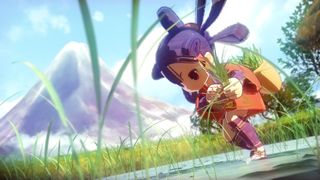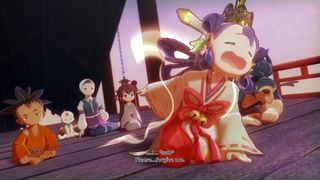Sakuna: Of Rice and Ruin's rice farming hooked me harder than Stardew Valley
I've never been this excited about rice paddies in my life.

I love the satisfaction of farming in games. Give me a fistful of virtual seeds and I'll pour my heart and soul into them until a bountiful harvest has sprouted from the ground. But out of all the farming games I've enjoyed recently—including Stardew Valley, My Time at Portia, Spiritfarer, and Ooblets—it's developer Edelweiss' demon-slaying action game Sakuna: Of Rice and Ruin that has offered the most satisfying virtual crop growing.

Best PC games: All-time favorites
Best free PC games: Freebie fest
Sims 4 cheats: Life hacks
GTA 5 cheats: Phone it in
GTA 6: Grand theft next
2021 games: This year's launches
The combination of a side-scrolling brawler and breezy rice farming simulator might seem like a disastrous mismatch, but Sakuna: Of Rice and Ruin makes the two work in perfect harmony. The art of rice growing is intricate and might seem a tad monotonous, but the game breaks it down in a way that makes rice field maintenance fun. Sakuna: Of Rice and Ruin made me individually plant one hundred rice seedlings and I loved every second.
You play as the title character, Sakuna, a harvest goddess, who alongside a group of humans gets banished to the Isle of Demons after ruining an important rice offering to the gods. Once there, she must investigate the origin of the demons and live off the land with the help of her new human companions. Although it will be a life of tough work, this banishment is ultimately a blessing in disguise.

Before being launched into the exciting world of rice farming, Sakuna needs to learn how to gather resources. Using her farm tools as weapons, you'll explore the island, brawling with monsters for meat and collecting important materials in a 2.5D side-scrolling perspective.
Combat is fun and scrappy, and when you're not brawling with the island's monsters, you'll need to hit bushes and rocks to farm for materials like stone, iron, wood, and food like acorns and mushrooms. When you return home you can use these materials to craft stronger weapons and add tasty flourishes to your meals.
Brawling with demons is fun and all, but the depth in Sakuna: Of Rice and Ruin is found in its rice-growing systems—it's some serious next level farming (I'm totally not joking). Taking care of the harvest throughout the year, switching up your plant treatment depending on the season, and making adjustments depending on what the rice crops need is the best part of the game.
Sakuna: Of Rice and Ruin made me individually plant one hundred rice seedlings and I loved every second.
Sakuna and her new human family need to grow rice as their main food resource to survive and it's the harvest goddess' job to plant, nurture, and harvest the rice. A day for Sakuna goes along the lines of checking on the rice crops, going out to scavenge and hunt for resources, and then spending the evening with the family, sharing stories and chatting over a hearty meal.
The biggest gaming news, reviews and hardware deals
Keep up to date with the most important stories and the best deals, as picked by the PC Gamer team.
Through a variety of mini-games Sakuna: Of Rice and Ruin walks through every step of rice paddy maintenance without skipping out on the manual labour that goes into it. To begin, you'll be individually planting each seedling, fifty of them to start, and then throughout the days you need to keep an eye out for weeds that need pulling and pests that need removing.
Part of this care is controlling the paddy's water irrigation system that involves the opening and closing of small gates that connect to a river. You can actually watch the rice paddy flood with water and decide when you want to stop it. During the Spring, it's important to make sure the seedlings have plenty of water, but then when Summer comes by you'll need to switch up your tactics and drain the paddy of water in what's called "midsummer drying."
These little intricate details can be found in all aspects of Sakuna's farming. There are so many things that can affect your crops, from the changes in weather, drops in temperature, and even what fertilizer you use.
It's lovely seeing your bumper crop of rice shoots swaying gracefully in the wind, but you're far from done. After collecting the crops (again, individually) you'll need to dry the bunches of them overnight and then begin the threshing process, which means removing the grain from their shoots. Following that, you'll then need to hull the grain, an important process where you remove the tough bits of husk. The more you hull, the whiter the rice becomes, which can result in different rice variations (the more you know!). Only after this string of mini-games is complete can you store your rice to last you through the winter, and then begin all over again the spring.
These mini-games sound like a lot of work, but I found each step fascinating. Most of the mini-games only require one or two buttons pressed over and over again, but with beautiful backdrop with peaceful music, the process feels soothing.
I'm only in my second year of rice growing in Sakuna: Of Rice and Ruin, but there are so many more systems and techniques that I need to learn. There are graphs and charts displaying all the different results of growing rice in certain ways that I have yet to try, modifying the taste, hardness, aroma, and stickiness of the rice.
Learning these different rice-growing techniques is encouraged throughout the game. How you grow your rice, through choices of different fertilizers and other elements, will affect the special abilities and fighting skills Sakuna gains. It's a neat way of tying the farming and fighting together so they don't feel isolated.
I love the level of detail that Sakura: Of Rice and Ruin brings to the practice of rice farming, and how much control it gives me to care for my crops. It's obvious that a lot of respect and passion for these delicate and important techniques has gone into the game, and I can't wait to jump back in and try out different harvesting methods.
Rachel had been bouncing around different gaming websites as a freelancer and staff writer for three years before settling at PC Gamer back in 2019. She mainly writes reviews, previews, and features, but on rare occasions will switch it up with news and guides. When she's not taking hundreds of screenshots of the latest indie darling, you can find her nurturing her parsnip empire in Stardew Valley and planning an axolotl uprising in Minecraft. She loves 'stop and smell the roses' games—her proudest gaming moment being the one time she kept her virtual potted plants alive for over a year.

Amazon's Mass Effect TV show now in 'active development' from the writer of F9: The Fast Saga (the one where a car goes to space)

Take-Two CEO says Grand Theft Auto 6 is on track for 'fall' next year, GTA 5 has sold over 205 million, and 'PC will be more and more a part of [our] business going forward'
Most Popular

